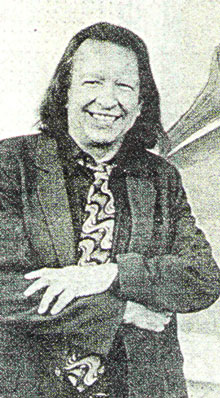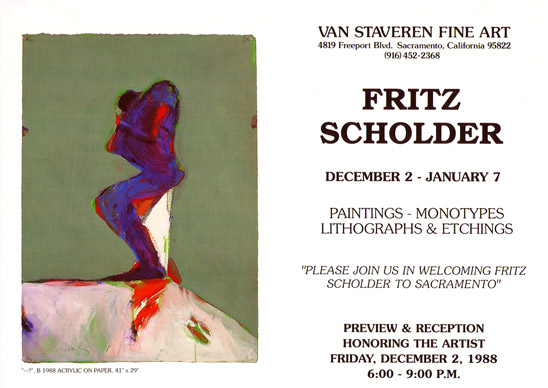 My
Interview with Fritz Scholder
My
Interview with Fritz Scholder
 My
Interview with Fritz Scholder
My
Interview with Fritz Scholder
SOME BACKGROUND: Born in Breckenridge, Minnesota in 1937, Fritz Scholder moved to Sacramento with his family at the age of 20. He already had experience making art, studying with the Sioux artist Oscar Howe in Pierre, South Dakota, and later with teachers in Lawrence, Kansas and at Wisconsin State University in Superior.
Painting classes at Sacramento City College in the late 1950s put him in contact with Wayne Thiebaud, who became another early influence. Scholder was invited by Thiebaud to join with him, Greg Kondos and Peter Vandenberg in opening a cooperative gallery in Sacramento, and eventually earned his first degree in fine art from Sacramento State University.
Scholder is also one-quarter Luseino Indian, a California mission tribe, and because of his heritage he was an appropriate candidate for making artworks that comment about both cultures. Scholderís first recognition came in 1967 from painting Native Americans in a contemporary Pop-esque style. The "Real Indian" series generated controversy because of Scholderís willingness to depict Native Americans detached somewhat from their traditional culture. Indians with beer cans, holding ice cream cones, standing near the Eiffel Tower, wearing high school jackets and cowboy hats, or draped in the American flag spoke with a kind of funny seriousness about a loss of heritage and the awkwardness of assimilating into Western society. It was honest commentary, but to his critics it appeared insensitive.
By the early 1970s Scholder ironically emerged as an influence on a new generation of savvy Native American artists, especially from the Southwest, who were also working in contemporary styles. My first encounter with his works came from a 1974 "Arizona Highways" magazine article. I had no idea back then that Scholder had a Sacramento connection. Apparently neither did author Joshua Taylor, Director of the National Collection of fine Art in Washington D.C., who mistakenly wrote that Scholderís formative years "came from the lively school of painters in the San Francisco area in the late 1950s."

THE 1988 INTERVIEW: Done on the day of Fritzís
first Sacramento show in years, it was a homecoming of sorts at the Van Staveren
Gallery, just down the street from his old alma mater at Sacramento City
College:
Ken Magri: "It seems that the social statements in your work arenít as specific anymore, yet a certain truthfulness still comes through."
Fritz Scholder: "Iíve always felt that a strong image is very important no matter what the subject is. All subjects now are visual clichťs. Weíre bombarded right from the beginning with television and billboards. We are visually too sophisticated, and this makes the challenge to the artist even greater."
KM: "How do you deal with that challenge in your subject matter?"
FS: "I especially like to work with singular figures because I guess Iíve always felt alone. I think most artists are rebels and Iíve never gone by the rules. In many ways itís difficult to talk about the work because Iíve always walked the line between discipline and accident, the unconscious. When you start thinking about it too much it just doesnít make it."
KM: "So you paint whatever comes to mind at the time?"
FS: "Itís autobiographical. There are certain things happening in my life, whether itís monster love, dreams, or a new dog. There should be humor. There should be danger and all kinds of things. I donít think about it. When Iím up in the studio itís often a surprise to me what happens."
KM: "How would you characterize your style in the context of Ď-ismsí or categories that critics and art historians create?"
FS: "I just donít go by the rules. The moment someone says to do something, I do the opposite. In fact Iím very suspect of groups that artists get into. I thought I would become a California artist, but then accidentally discovered the Southwest."
KM: "So now you fight the label of being called a Southwest artist?"
FS: "Labels are so misleading. Almost everyone has to fight against what they become famous for. Itís the way it is with the media. The media grabs you, uses you, then spits you out, and unfortunately they donít follow up."
KM: "Driving past Sacramento City College today must have started some memories."
FS: "Of course. For all the young starving artists at the time (Wayne) Thiebaud was our mentor. I got to Sacramento City College just when he decided to paint cereal boxes and pies. We thought he had gone nuts because he was doing very well with his impressionistic landscapes. We all went out to the malls on weekends and set up card tables and sold drawings; me, (Mel) Ramos, Thiebaud and the restÖand we would all make enough to go party or whatever. It was a very active time for a lot of artists."
KM: "Now youíre living in New York,
Southern California and Arizona. Are there any artists on the contemporary scene
that you especially like?"
FS: "Well I contend that (Anselm) Kiefer is the top guy today,
and before him it was (Joseph) Bueys."
KM: "Itís interesting that you mentioned two Germans rather than Americans."
FS: "America lost out on its edge years ago, especially in New York. They donít like to admit it but they did. Kiefer is the guy that has the guts, the audacity. But I have trouble with knowing all that straw (worked into his paintings) is either going to rot or fall out, because an artist has a certain responsibility to permanence."
KM: "Like the way Julian Schnabel has to go back and re-glue the crockery onto his canvases?"
FS: "Now that guy completely canceled out. Heís
for the birds. When you see Kieferís huge paintings with stuff hanging out, itís
there because it should be there. It makes it. Schnabel is too self-conscious.
In this country Richard Diebenkorn is the best living painter, and he is very
precise. I caught his opening at the Museum of Modern art, just the paper works,
and at first I thought ĎWhy didnít they show his big glorious paintings?í
But even the paper works make one of the best shows in a long time. To my
knowledge heís the only living California artist who has had a major show at
the Museum of Modern Art, so thatís terrific."
UPDATE:
Since 1988 Scholder has published seven books and has had major exhibitions in Phoenix, Santa Fe, Duluth, and Scottsdale, Arizona. He has traveled to London, Paris, Budapest and New Hampshire to work on art. In 2000 he produced his first digital book, Thoughts at Night. In 2002 he was the recipient of the Arizona Governorís Award. He currently lives in Scottsdale and his official web site is www.scholder.com, from which some of the above biographical information was taken.-Ken Magri, April 2004